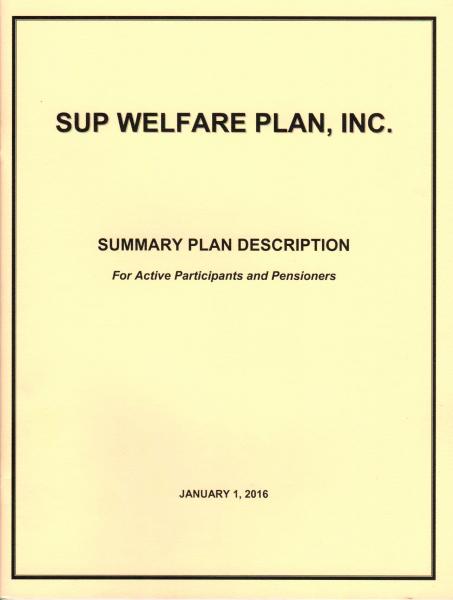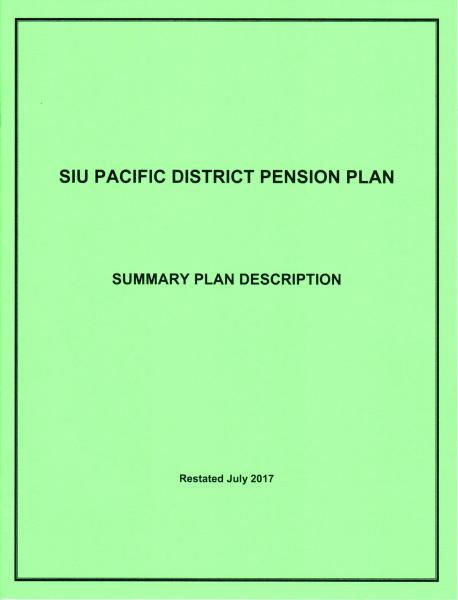ANNUAL FUNDING NOTICE
For
SIU Pacific District Pension Plan
Introduction
This notice, which federal law requires all pension plans to furnish on an annual basis, includes important information about the funding status of your multiemployer pension plan (the “Plan”). It also includes general information about the benefit payments guaranteed by the Pension Benefit Guaranty Corporation (“PBGC”), a federal insurance agency. All traditional pension plans (called “defined benefit pension plans”) must provide this notice every year regardless of their funding status. This notice does not mean that the Plan is terminating. It is provided for informational purposes and you are not required to respond in any way. This notice is required by federal law. This notice is for the plan year beginning August 1, 2014 and ending July 31, 2015 (the “2014 Plan Year”).
How Well Funded Is Your Plan
The law requires the administrator of the Plan to tell you how well the Plan is funded, using a measure called the “funded percentage.” The Plan divides its assets by its liabilities on the Valuation Date for the plan year to get this percentage. In general, the higher the percentage, the better funded the plan. The Plan’s funded percentage for the Plan Year and each of the two preceding plan years is shown in the chart below. The chart also states the value of the Plan’s assets and liabilities for the same period.
|
Funded Percentage |
|||
|
|
2014 Plan Year |
2013 Plan Year |
2012 Plan Year |
|
Valuation Date |
August 1, 2014 |
August 1, 2013 |
August 1, 2012 |
|
Funded Percentage |
Over 100% |
Over 100% |
Over 100% |
|
Value of Assets |
$105,886,470 |
$106,718,842 |
$110,679,929 |
|
Value of Liabilities |
$83,624,556 |
$90,126,169 |
$90,249,292 |
Year-End Fair Market Value of Assets
The asset values in the chart above are measured as of the Valuation Date. They also are “actuarial values.” Actuarial values differ from market values in that they do not fluctuate daily based on changes in the stock or other markets. Actuarial values smooth out those fluctuations and can allow for more predictable levels of future contributions. Despite the fluctuations, market values tend to show a clearer picture of a plan’s funded status at a given point in time. The asset values in the chart below are market values and are measured on the last day of the Plan Year. The chart also includes the year-end market value of the Plan’s assets for each of the two preceding plan years. The value of the Plan assets shown as of July 31, 2015 is an estimate based on the most accurate unaudited financial information available at the time this notice was prepared. The final audited information on the Plan’s assets will be reported on the Plan’s 2014 annual report filed with the Department of Labor in May 2016.
|
|
July 31, 2015 |
July 31, 2014 |
July 31, 2013 |
|
Fair Market Value of Assets |
$107,908,514 |
$111,642,407 |
$110,282,261 |
Endangered, Critical, or Critical and Declining Status
Under federal pension law, a plan generally is in “endangered” status if its funded percentage is less than 80 percent. A plan is in “critical” status if the funded percentage is less than 65 percent (other factors may also apply). A plan is in “critical and declining” status if it is in critical status and is projected to become insolvent (run out of money to pay benefits) within 15 years (or within 20 years if a special rule applies). If a pension plan enters endangered status, the trustees of the plan are required to adopt a funding improvement plan. Similarly, if a pension plan enters critical status or critical and declining status, the trustees of the plan are required to adopt a rehabilitation plan. Funding improvement and rehabilitation plans establish steps and benchmarks for pension plans to improve their funding status over a specified period of time. The plan sponsor of a plan in critical and declining status may apply for approval to amend the plan to reduce current and future payment obligations to participants and beneficiaries.
The Plan was not in endangered, critical, or critical and declining status in the Plan Year.
Participant Information
The total number of participants and beneficiaries covered by the Plan on the valuation date was 2,116. Of this number, 856 were current employees, 1,246 were retired and receiving benefits, and 14 were retired or no longer working for the employer and have a right to future benefits.
Funding & Investment Policies
Every pension plan must have a procedure to establish a funding policy for plan objectives. A funding policy relates to how much money is needed to pay promised benefits. Plan benefits are funded by employer contributions and investment returns on those contributions. The shipping companies have not been required to make contributions to the Plan since August 1, 1993, and may agree through collective bargaining to make contributions in the future as necessary to satisfy the minimum funding standards of the Employee Retirement Income Security Act of 1974 (“ERISA”) and the Internal Revenue Code (“Code”). Since August 1, 1993, Plan benefits have been funded by the Plan’s investment income. The Plan’s funding policy is to continue to fund Plan benefits in this manner in accordance with the minimum funding standards of ERISA and the Code.
Pension plans also have investment policies. These generally are written guidelines or general instructions for making investment management decisions. The investment policy of the Plan is to maintain a portfolio of investments which is conservative in nature. The Trustees, working with experienced investment consultants, monitor and make appropriate changes to the Plan’s investments, seeking to achieve positive investment results over the long term.
Under the Plan’s investment policy, the Plan’s assets were allocated among the following categories of investments, as of the end of the Plan Year. These allocations are percentages of total assets:
|
Asset Allocations |
Percentage |
|
1. Cash (Interest bearing and non-interest bearing) |
7.8% |
|
2. U.S. Government securities |
18.2% |
|
3. Corporate debt instruments |
26.1% |
|
4. Corporate stocks (other than employer securities): |
47.9% |
|
5. Other |
0.0% |
Right to Request a Copy of the Annual Report
Pension plans must file annual reports with the US Department of Labor. The report is called the “Form 5500.” These reports contain financial and other information. You may obtain an electronic copy of your Plan’s annual report by going to www.efast.dol.gov and using the search tool. Annual reports also are available from the US Department of Labor, Employee Benefits Security Administration’s Public Disclosure Room at 200 Constitution Avenue, NW, Room N- 1513, Washington, DC 20210, or by calling 202-693-8673. Or you may obtain a copy of the Plan’s annual report by making a written request to the plan administrator, Ms. Michelle Chang, at 730 Harrison Street, Suite 400, San Francisco, CA 94107. Annual reports for the 2013 Plan Year and earlier Plan Years are available now. The annual report for the 2014 Plan Year will be available when it is filed with the Employee Benefits Security Administration in May 2016. Annual reports do not contain personal information, such as the amount of your accrued benefit. You may contact the plan administrator at 415-764-4993 or the address above if you want information about your accrued benefits.
Summary of Rules Governing Insolvent Plans
Federal law has a number of special rules that apply to financially troubled multiemployer plans that become insolvent, either as ongoing plans or plans terminated by mass withdrawal. The plan administrator is required by law to include a summary of these rules in the annual funding notice. A plan is insolvent for a plan year if its available financial resources are not sufficient to pay benefits when due for that plan year. An insolvent plan must reduce benefit payments to the highest level that can be paid from the plan’s available resources. If such resources are not enough to pay benefits at the level specified by law (see Benefit Payments Guaranteed by the PBGC, below), the plan must apply to the PBGC for financial assistance. The PBGC will loan the plan the amount necessary to pay benefits at the guaranteed level. Reduced benefits may be restored if the plan’s financial condition improves.
A plan that becomes insolvent must provide prompt notice of its status to participants and beneficiaries, contributing employers, labor unions representing participants, and PBGC. In addition, participants and beneficiaries also must receive information regarding whether, and how, their benefits will be reduced or affected, including loss of a lump sum option.
This Plan is not insolvent and not in reorganization, and is over 100% funded.
Benefit Payments Guaranteed by the PBGC
The maximum benefit that the PBGC guarantees is set by law. Only benefits that you have earned a right to receive and that cannot be forfeited (called vested benefits) are guaranteed. There are separate insurance programs with different benefit guarantees and other provisions for single-employer plans and multiemployer plans. Your Plan is covered by PBGC’s multiemployer program. Specifically, the PBGC guarantees a monthly benefit payment equal to 100 percent of the first $11 of the Plan’s monthly benefit accrual rate, plus 75 percent of the next $33 of the accrual rate, times each year of credited service. The PBGC’s maximum guarantee, therefore, is $35.75 per month times a participant’s years of credited service.
Example 1: If a participant with 10 years of credited service has an accrued monthly benefit of $600, the accrual rate for purposes of determining the PBGC guarantee would be determined by dividing the monthly benefit by the participant’s years of service ($600/10), which equals $60. The guaranteed amount for a $60 monthly accrual rate is equal to the sum of $11 plus $24.75 (.75 x $33), or $35.75. Thus, the participant’s guaranteed monthly benefit is $357.50 ($35.75 x 10).
Example 2: If the participant in Example 1 has an accrued monthly benefit of $200, the accrual rate for purposes of determining the guarantee would be $20 (or $200/10). The guaranteed amount for a $20 monthly accrual rate is equal to the sum of $11 plus $6.75 (.75 x $9), or $17.75. Thus, the participant’s guaranteed monthly benefit would be $177.50 ($17.75 x 10).
The PBGC guarantees pension benefits payable at normal retirement age and some early retirement benefits. In addition, the PBGC guarantees qualified preretirement survivor benefits (which are preretirement death benefits payable to the surviving spouse of a participant who dies before starting to receive benefit payments). In calculating a person’s monthly payment, the PBGC will disregard any benefit increases that were made under a plan within 60 months before the earlier of the plan’s termination or insolvency (or benefits that were in effect for less than 60 months at the time of termination or insolvency). Similarly, the PBGC does not guarantee benefits above the normal retirement benefit, disability benefits not in pay status, or non-pension benefits, such as health insurance, life insurance, death benefits, vacation pay, or severance pay.
For additional information about the PBGC and the pension insurance program guarantees, go to the Multiemployer Page on PBGC’s website at www.pbgc.gov/multiemployer. Please contact your employer or plan administrator for specific information about your pension plan or pension benefit. PBGC does not have that information. See “Where to Get More Information” below.
Where to Get More Information
For more information about this notice, you may contact Ms. Michelle Chang, Administrator, SIU Pacific District Pension Plan, at 730 Harrison Street, Suite 400, San Francisco, CA 94107, 415-764-4993. For identification purposes, the official plan number is 001, the plan sponsor is the Board of Trustees of the SIU Pacific District Pension Plan, and the employer identification number or “EIN” is 94-6061923.




